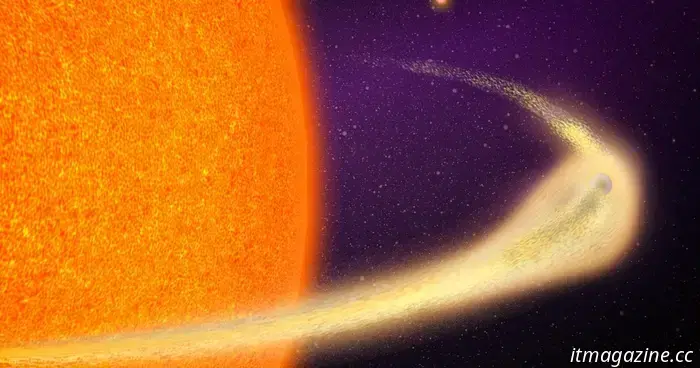
This planet is breaking apart, resulting in a massive tail similar to that of a comet.
Astronomers from the Massachusetts Institute of Technology (MIT) have made a remarkable discovery by identifying a planet that is currently disintegrating. As it breaks apart, it is leaving behind a comet-like tail of material.
The planet, known as BD+05 4868 A, is situated 140 light-years from Earth and has a mass comparable to that of Mercury. However, unlike Mercury, this planet has an exceptionally tight orbit around its host star, resulting in a year that lasts just over 30 hours. Its proximity to the star leads to extreme temperatures nearing 3,000 degrees Fahrenheit, causing the planet to be enveloped in magma that is vaporizing into space.
As the planet travels in its orbit, material from its surface is being eroded and evaporated, generating a massive trail of debris behind it, akin to the behavior of comets when they approach the sun.
“The length of the tail is enormous, reaching up to 9 million kilometers, or about half of the planet’s full orbit,” stated chief researcher Marc Hon from MIT. “We weren't searching for such a planet; we were conducting standard planet vetting when I noticed this very peculiar signal.”
The researchers became intrigued by this extensive tail, which produced a distinctive signal as it passed in front of its host star. This is a common method used by astronomers to discover exoplanets, as they look for slight drops in a star's brightness when a planet transits in front of it. In this instance, the transit appeared to have an unusually long duration and varied slightly with each orbit, suggesting that the shape of the planet changes slightly each time—indicating the presence of a tail.
“The shape of the transit resembles that of a comet with a long tail,” Hon clarified. “However, it’s improbable that this tail contains volatile gases and ice, as we would expect from a traditional comet—these wouldn’t endure long due to the star's closeness. Nevertheless, mineral grains evaporating from the planet's surface can persist long enough to form such a distinctive tail.”
This particular planet is shedding material due to its relatively low mass, which results in weaker gravity that allows for easier loss of surface material. It stands as one of just four known disintegrating planets, and importantly, it is the closest to Earth among them. Researchers are keen to investigate it further with the James Webb Space Telescope.
However, they must act quickly since the planet is disintegrating and not expected to last indefinitely. As it loses material, its gravity diminishes, causing it to shed material at an even faster rate. According to fellow researcher Avi Shporer, it’s a “runaway process.”
“We were fortunate to observe it precisely as it is fading away,” Shporer remarked. “It’s akin to being on its last breath.”
The findings are documented in the Astrophysical Journal Letters.
Other articles
 GOG brings back a classic RPG over twenty years after its original release.
Breath of Fire IV has been upgraded and modernized for Windows 10 and 11, featuring complete controller support.
GOG brings back a classic RPG over twenty years after its original release.
Breath of Fire IV has been upgraded and modernized for Windows 10 and 11, featuring complete controller support.
 The Kindle Colorsoft Signature Edition is Amazon’s top new release, and it’s currently available at a 20% discount.
The standout feature of the Kindle Colorsoft is its color display, but it is also a full Kindle, featuring a waterproof design. You can now purchase it for only $225, which is a $55 discount.
The Kindle Colorsoft Signature Edition is Amazon’s top new release, and it’s currently available at a 20% discount.
The standout feature of the Kindle Colorsoft is its color display, but it is also a full Kindle, featuring a waterproof design. You can now purchase it for only $225, which is a $55 discount.
 The top budget AV receiver is now on sale.
Enhance your home theater experience with the Sony STRDH590 5.2ch AV Receiver, currently available for $350 at select retailers.
The top budget AV receiver is now on sale.
Enhance your home theater experience with the Sony STRDH590 5.2ch AV Receiver, currently available for $350 at select retailers.
 This overlooked Tom Hanks war film is set to receive a sequel.
Tom Hanks will return to his role as Commander Ernie Krause in the sequel to Greyhound, which has now been given a start date and plot details.
This overlooked Tom Hanks war film is set to receive a sequel.
Tom Hanks will return to his role as Commander Ernie Krause in the sequel to Greyhound, which has now been given a start date and plot details.
 The Nothing Ear wireless earbuds featuring ChatGPT integration are currently available at a 28% discount.
The Nothing Ear wireless earbuds, featuring active noise cancellation and integration with ChatGPT, are currently available on Amazon for just $114 following a 28% discount.
The Nothing Ear wireless earbuds featuring ChatGPT integration are currently available at a 28% discount.
The Nothing Ear wireless earbuds, featuring active noise cancellation and integration with ChatGPT, are currently available on Amazon for just $114 following a 28% discount.
 Slate Introduces $20K Electric Truck That Converts into an SUV
Slate has introduced a $20,000 electric truck that can convert into an SUV.
Slate Introduces $20K Electric Truck That Converts into an SUV
Slate has introduced a $20,000 electric truck that can convert into an SUV.
This planet is breaking apart, resulting in a massive tail similar to that of a comet.
Astronomers have found an unusual planet that is in the process of disintegrating.
